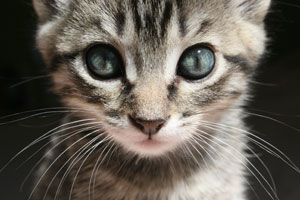These three facts alone are reason enough to feel the effects of a conundrum, but let's explore further.
Fact: Flushing cat poop down the toilet is an option once suggested by environmentalists, but is now an eco- No-No. Toxoplasma gondii, a parasite found in cat's intestines, can be passed through the feces.
When flushed, the T. Gondii travels with the toilet water from your house to a treatment center (where it resists treatment) to the bay to the Pacific Ocean and into the habitat of many sea creatures, including the Sea Otter.
A UC Davis study of otters that live in areas near freshwater runoff, found that 42% of live otters and 62% of dead otters tested positive for T. Gondii.
In fact, recent legislation will require kitty litters bags to include warning labels about flushing.
(Editor's note: QUEST's very first TV story, ""What's Killing the Sea Otters?" - 2/6/07- " covers this topic in detail.)
Now that we are clear on the conundrum, let's explore some options.
Reclaimed Wood Litter: Litter made from reclaimed wood is an greener option. Pine and cedar sawdust that would normally end up in landfills is concentrated without the use of dangerous chemicals to produce environmentally safe litter. Feline Pine, Nature's Earth and Catfresh are options.
Recycled Newspaper Litter: Try litter made from recycled newspapers. The paper absorbs just as well and re-uses resources. Two great brands are Yesterdays News and Good Mews.
Plant-based Litters: Plant-based litters are made from materials such as corn, corncobs, cornhusks, wheat by-products, wheat grass and beet pulp. These biodegradable materials, have no odor, are very absorbent and don't produce the same kind or volume of dust as clay litters.
Biodegradable Bags: These are available at most pet stores. Use the biodegradable litter with them.
Composting: Being a Zoo employee, we are BIG composters of our herbivore poop, creating rich and wonderful soil to grow our botanical paradise at Knowland Park. NatureMill, makers of the pet-friendly composter claim that it is possible to compost pet poop, as well. This composter, made from recycled and recyclable materials, is an easy to use alternative. Just add food scraps and the computerized composter heats up the ingredients to the 140 degrees (the EPA suggests over 130 degrees). Out comes soil for your flowerbed.
Make Your Own Kitty Litter: The DIY-crowd may even wish to attempt a hand-crafted solution.
These are all great alternatives that, of course, present more questions. Like all environmental issues these days, each solution may lead to a new puzzle or conundrum for us to wrap our greening brains around. Let's keep on exploring!
37.7772 -122.166595
 What are the options for eco-friendly cat litter?In researching this blog post, I continually ran across the word "conundrum" - which is defined as a puzzling question or problem. Used in a sentence, one might say, "I am a cat owner who cares about the environment. What to do about their poop presents quite a conundrum."
What are the options for eco-friendly cat litter?In researching this blog post, I continually ran across the word "conundrum" - which is defined as a puzzling question or problem. Used in a sentence, one might say, "I am a cat owner who cares about the environment. What to do about their poop presents quite a conundrum."